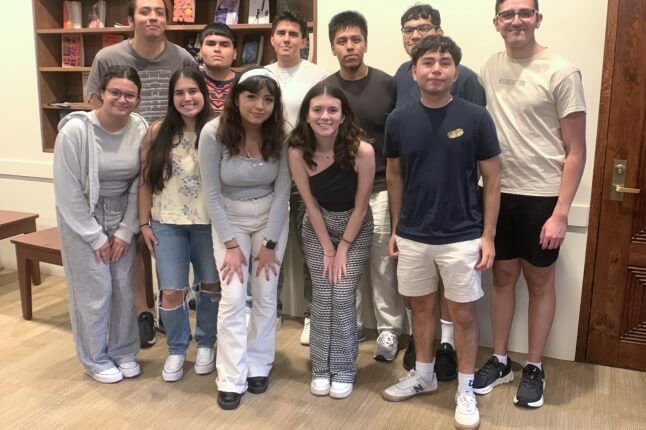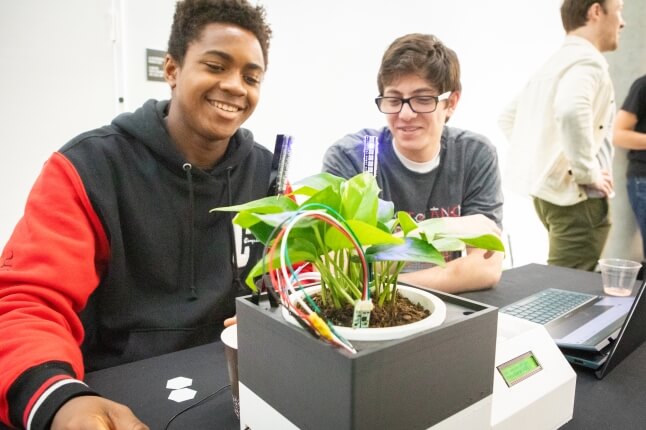News
Joe Pappas watched with bated breath as the racecars rounded the final turn. He cheered as his team’s car coasted across the finish line, decelerating from a top speed of 25 miles per hour.
Mechanical engineering concentrator Joe Pappas, S.B. '17, and applied math concentrator Daphne Kaxiras, A.B. '21, make final adjustments to the SEAS Racing Team car before entering the first round of technical inspections. (Photo courtesy of Joe Pappas)
Rather than fueling their need for speed, racers in the SAE Supermileage Competition went head-to-head in a fuel efficiency contest. The team from the Harvard John A. Paulson School of Engineering and Applied Sciences (SEAS) achieved an average of 449 miles per gallon, earning 12th place out of 33 competing universities.
“I’m very proud of how we did, considering this was our first time in the competition,” said Pappas, who graduated with a mechanical engineering degree in the winter of 2017. “Two of us showed up with little more than our car and a few spare parts and competed against much larger, well established teams. I was very proud of the team and what we put together.”
For Pappas, this race was years in the making.
Construction on the car began during his sophomore year, when a team of students planned to enter an electric vehicle competition. The team had nearly finished the body of the car when they learned they would not be able to compete.
The project was scrapped and the team disbanded, but Pappas refused to be discouraged. He set his sights on entering the SAE Supermileage Competition, a race with completely different objectives and specifications.
He gathered a team of students and set to work rebuilding the chassis, transmission, and steering system. At the heart of the racecar lies the student-built 31cc internal combustion engine, which Pappas and team member Sean Vedrinelle S.B. ’17, an applied math concentrator, designed and fabricated specifically for the competition under the guidance of faculty advisor Peter Stark, Lecturer on Engineering Sciences. The engine features all custom parts designed for efficiency, including 3D printed nylon cams, an adjustable overhead cam shaft, a cross-flow cylinder head with variable twin-spark ignition, and a pressurized lubrication system.
Each task involved trial and error as team members learned to use new materials, like carbon fiber, and new techniques, such as computer simulations, along the way.
SAE Supermileage Competition officials conduct a thorough technical inspection of the SEAS Racing Team car. (Photo courtesy of Joe Pappas)
“The process was an incredible learning experience,” Pappas said. “Not only did we learn about specific things like engine design and sources of drag in rotating machinery, but we gained valuable experience in being able to take on new challenges and learn quickly.”
Building a race-worthy car for this competition presented unique challenges.
For instance, even a tiny bit of resistance can be a huge drag when striving for peak fuel efficiency, explained Ethan Seder, S.B. ’21, a mechanical engineering concentrator. Rather than using a premade transmission, the team built one that used rotational energy to automatically disengage the transmission when the engine is off to reduce drag while coasting.
Those big projects were challenging, but so were dozens of smaller tasks, like designing an effective seat belt that could be squeezed into the extremely tight cockpit
“The devil is in the details, and there were a lot of small things we needed to complete this year to be ready for the competition,” Seder said. “It is the worst feeling when you’ve spent 15 hours working on a part and it breaks when you try to assemble it. But having a team that supports you helps you push through those long hours and late nights in the machine shop.”
Pappas and Kaxiras offer an oral presentation about their car to the SAE Supermileage Competition judges. (Photo courtesy of Joe Pappas)
All that frustration melted away the first time Seder saw the car in action.
“My favorite memory was right before spring break, sitting in the car for the first time and being able to fire up the engine,” he said. “Turning off the motor and just gliding 200 yards on a completely flat surface was pretty sweet.”
But having a drivable car was only half the battle; before they could race, the car had to pass a rigorous technical inspection.
When Pappas and Daphne Kaxiras, A.B. ’21, an applied math concentrator, arrived in Michigan, they quickly saw just how strict the technical inspection was.
“It became clear why the veteran teams brought trailers full of equipment to repair technical issues, and it was discouraging to see three teams fail the inspection and go home, but I was confident because of our strong preparation, and I knew we could come up with a solution to anything that might come up,” Pappas said.
For all teams, passing technical inspection is a compromise between track performance and rule adherence. The most difficult part of inspection was the brake test.
“We wanted to see just how loose our brake pads could be to avoid any incidental contact between the brake pad and rotor,” Pappas said. “It took 17 attempts to pass the test, and eventually we did it by making a sharp turn in the braking zone, effectively lengthening the permitted braking distance.”
Yet passing the rigorous inspections didn’t mean everything was easy on the racecourse.
“I hit 28 miles per hour, and we hadn’t tested the car at that speed, so we didn’t know the rivets wouldn’t hold the windshield, which was damaged during transportation,” Kaxiras said. “The whole top of the car was coming off and air was rushing in, so I had to hold the windshield down and also steer. That was our first run, and I was determined to finish it, so I held on for dear life and I made it.”
Their strategy was to burn fuel while climbing hills and then coast to the bottom, keeping the average speed above the minimum of 15 miles per hour, but not exceeding the 25 mile-per-hour maximum.
Kaxiras pauses for a moment to unwind after the end of a race. (Photo courtesy of Joe Pappas)
Though she couldn’t see very well due to the car’s aerodynamic shape, Kaxiras was bent on doing her part on the track. Squeezed into the vehicle, helmet and all, during each 40-minute run, she said the races passed in the blink of an eye.
“Every time the safety car would drive by, I would fear the worst, but Daphne made it all six laps in good shape,” Pappas said.
Standing side-by-side on the quiet track at the end of a long day of racing, he and Kaxiras felt a mix of relief and jubilation.
They hope to channel that excitement into next year’s project. With a positive first result, Pappas is excited to see what the students will come up with.
Seder, who was encouraged to concentrate in mechanical engineering because of the SEAS Racing Team, is excited to take up that mantle with Kaxiras.
“I really enjoyed the team aspect, and I especially enjoyed fine-tuning my own machining skills,” he said. “Now, I can look at a wide variety of mechanical things and understand, from an engineering perspective, how they are built and how I could improve them. With a desire to jump in and learn, some self-reliance and independence, and also a strong sense of teamwork, it is amazing what you can do.”
Topics: Student Organizations
Cutting-edge science delivered direct to your inbox.
Join the Harvard SEAS mailing list.


